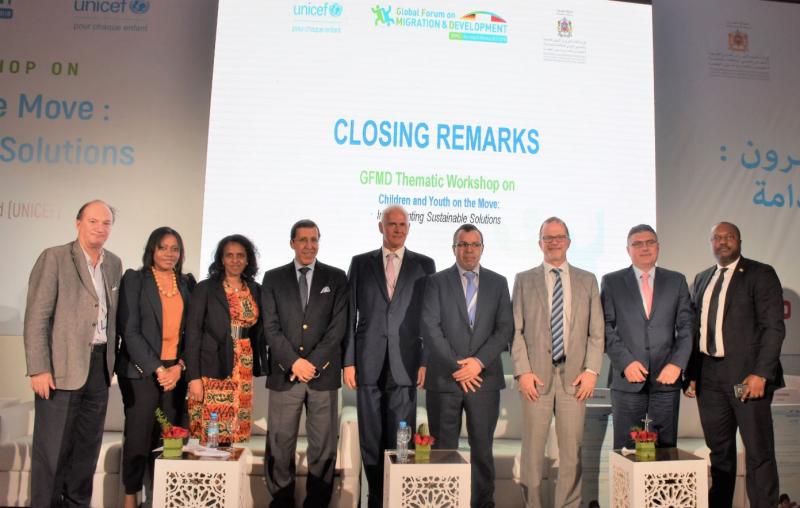

Agadir, Morocco – On 21-22 June 2018, the GFMD 2017-2018 Co-Chairmanship of Germany and Morocco, in partnership with the United Nations Children’s Fund (UNICEF), organized a thematic workshop entitled, “Children and Youth on the Move: Implementing Sustainable Solutions” to inform ongoing inter-governmental negotiations on the Global Compact for Migration (GCM) on priority issues for children and youth on the move.
Ambassador Götz Schmidt-Bremme and Mr. El Habib Nadir, respectively representing the German and Moroccan GFMD Co-Chairs, welcomed over 180 migration and development policymakers and practitioners from governments, international organizations, civil society, private sector and young migrants themselves. Thirteen (13) young people with migrant backgrounds served as speakers and active participants in the various sessions. For most of them, this workshop was a first opportunity to dialogue with government policymakers and other concerned actors.
At the opening session, Mr. Nadir emphasized the importance of the issue of youth migration for the international community. He elaborated on his country’s 2013 National Strategy for Immigration and Asylum which includes a host of provisions for the regularization and integration of migrants, as well as access to services for migrant children. “We must also pay tribute to civil society organizations for their advocacy […] for the protection of the rights of migrant children,” he added.
With a view towards Marrakesh, Mr. Ted Chaiban, Director of Programmes for UNICEF, expressed the hope that the participants would leave Agadir with clear ideas and commitments of how they can support migrant children through practical steps and partnerships. Speaking on behalf of young people on the move, Mr. Anas Ansar, Central and South Asia focal point of the UN Migration Group for Children and Youth, highlighted the global emergence of voluntary and involuntary movements of children and the youth. He lauded the GFMD and UNICEF for making the youth a part of the workshop because he believed that “one way of making migration safer for young people is for them to be part of the discussion.”
In the session entitled “Being a Young Migrant – from Object to Subject. Why and How Should You Invest in Us?,” GFMD kicked off its first all youth-led panel. All 13 young people – who have come from Morocco, Gambia, Nigeria and Romania and, some of whom, are now living in Italy, Germany, and the UK – livened the space by performing a skit that communicated the importance of social inclusion for young migrants in the host society. They issued three calls to action and recommendations for the GCM: a) to integrate young migrants while allowing them to preserve their cultural identities; b) to recognize achievements and school and, or university degrees of young migrants who move across borders; and c) to enable meaningful participation and equip young migrants to become change makers in their communities.


The two-day workshop identified four priority policy areas that need to be addressed in pursuit of the commitments laid out in the GCM, namely: protection, access to services and integration, inclusion and data collection and use. In each session, panelists and participants brought to light the main challenges and opportunities, and shared some relevant good practices at the country and regional levels. (See below for the highlights of the discussions).
“We should not implement anything for the children without the children.”
- Mr. Ted Chaiban, Director of Programmes, UNICEF
Mr. Chaiban summed up five key takeaways of the workshop in 5 “P”s: Participation, Practices, Policies, People, and in particular, Partnerships – which calls for a strong cooperation between the GFMD and UNICEF. His concluding remarks inspired those in the room when he said, “Let’s leave here with a bag full of commitments and actions. This is not where it stops. This is where we continue to do things with and for child migrants.”
In closing, Ambassador Schmidt-Bremme thanked the participants and highlighted the importance of including children and the youth in the discussion. “Let me assure you that your voices were heard,” the German GFMD Co-Chair affirmed. He then articulated Germany’s centrepiece of inclusion and protection approaches for young migrants which focus on (1) ensuring the availability of quality data on migrant children, (2) child protection systems that support alternatives to detention and (3) child protection measures during instances of involuntary return. These three approaches, he shared, could also serve as examples of how the objectives of the GCM could be implemented to achieve the common goal of making migration safe, orderly and regular at all stages – especially for children and youth on the move.
Highlights of the Working Sessions
|
Working Session
|
Challenges |
Opportunities |
|
Session I: Data to Protect, Data to Inform, Data to Deter? |
|
|
|
Session II: Protecting Children and Young Migrants Across Borders |
|
|
|
Session III: Africa – A Continent on the Move? |
|
|
|
Session V: Pathways Out of Vulnerability, Access to Services and Sustainable Solutions for Children and Families |
|
|
|
Session VI: Partnerships For and With Migrant Children and Youth |
|
|
Please clink this link to view the photos of the two-day GFMD Thematic Workshop.
Disclaimer: To protect the identity of the young migrants in this workshop, their pictures will not be published.